(完整版)英语人教版八年级下册unit3A1a-1c教案
- 格式:pdf
- 大小:17.07 KB
- 文档页数:2
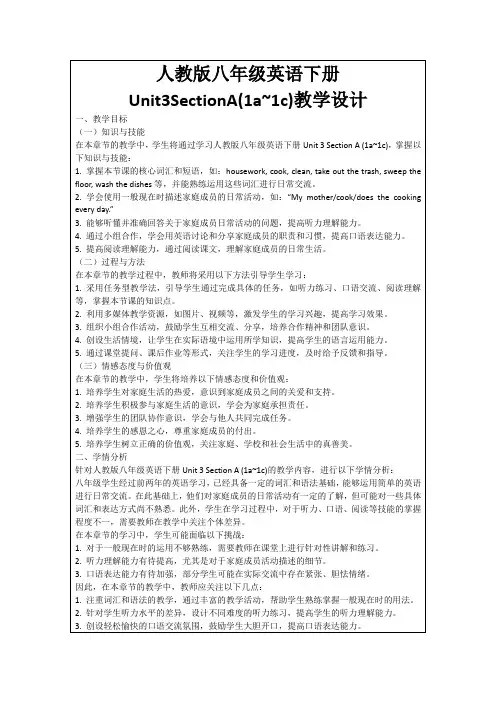
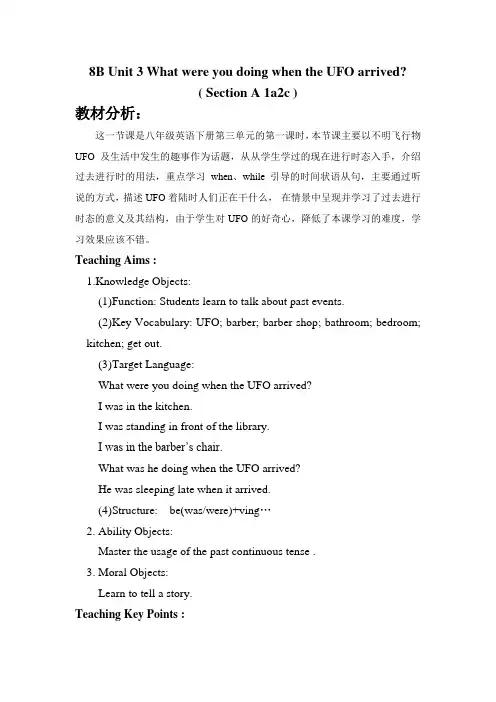
8B Unit 3 What were you doing when the UFO arrived?( Section A 1a2c )教材分析:这一节课是八年级英语下册第三单元的第一课时,本节课主要以不明飞行物UFO及生活中发生的趣事作为话题,从从学生学过的现在进行时态入手,介绍过去进行时的用法,重点学习when、while 引导的时间状语从句,主要通过听说的方式,描述UFO着陆时人们正在干什么,在情景中呈现并学习了过去进行时态的意义及其结构,由于学生对UFO的好奇心,降低了本课学习的难度,学习效果应该不错。
Teaching Aims :1.Knowledge Objects:(1)Function: Students learn to talk about past events.(2)Key Vocabulary: UFO; barber; barber shop; bathroom; bedroom; kitchen; get out.(3)Target Language:What were you doing when the UFO arrived?I was in the kitchen.I was standing in front of the library.I was in the barber’s chair.What was he doing when the UFO arrived?He was sleeping late when it arrived.(4)Structure: be(was/were)+ving…2. Ability Objects:Master the usage of the past continuous tense .3. Moral Objects:Learn to tell a story.Teaching Key Points :The usage of the past continuous tense.Teaching Difficult Points :(1)The form of the past continuous tense.(2)How to use the past continuous tense in the adverb clause of time leaded by “when”and “while”.Teaching Methods :Situation teaching method. Taskbased teaching method.Teaching Aids :A tape recorder, some pictures, PPT.Teaching Procedures :Step 1 Revision1. Exchange greetings2. An oral report done by a student.Step 2 Revision1. Show four animation pictures on the screen.After showing the pictures, ask:-What is Peter’s mother doing?-She is cooking.-What is Peter’s father doing?-He is watching TV.-What is Peter doing?-He is sleeping late.-What is Peter’s brother doing?-He is getting out of the shower.2. Lead the students into the real situations:T: What are you doing now?T(Ask the whole class):What is he doing?S(The whole class answer):He is listening to you.Repeat this with one girl student. Practice with the whole class, trying to revise the tense with different personal pronouns.Step3 Leading inIntroduce the past continuous tense to the students.1. Show a picture to a student and ask the student to act the action out.For example:I am writing.Ask the whole class: What is he doing?The whole class answer: He is writing.Then ask the student who I asked the students?Help him answer: I was writing when you asked the students.Repeat this with other students, Practice with the whole class, trying to revise the tense with different personal pronouns.2. Practice another situation: What were you doing when the student A came in?3. Point to the blackboard—writing (During my teaching above, I have written it on the blackboard step by step). Help them to find out the differences between the two pairs of sentences. Tell the students:Today we are going to learn a new tense—the past continuous tense.Step 4 PairworkPage 18 Activity 1a1. Show a picture of all kinds of UFOs.T: What is UFO? Do you know?S(Help students answer): Unidentified Flying Object2. Show a picture of all kinds of aliens.T: What are they?Teach: Aliens.Discuss: What does the aliens look like?Students answer according to their imaginations.3. Show the picture on Page 18 on the screen.Talk about the picture with the students.T: A reporter was asking some people “What were you doing when the UFO arrived?” Please look at the picture and match the statements with the people in the picture.4. Pairwork: Where were you when the UFO arrived? I was in…Step 5 ListeningPage 18 Activity 1b1. Listen and circle the answers. Check answers with students.2. Pairwork: Make conversations like the following sentences.What were you doing when the UFO arrived?I was…ing when…(Students make sentences to practice “when” and “while” with the other answer provided in 1b.)Step 6 Pairwork :Page 18 Activity 1c .A: Where was the girl when the UFO arrived?B: She was in front of the library.A: What was she doing when the UFO arrived?B: She was standing in front of the library.(Ask students to ask and answer in Pairs.)Step 7 Listening1. Page 19 Activity 2a .Listen and number the statements in the order you hear them .Check the answers .2. Page 19 Activity 2b .Listen again .Complete the following sentences with“when” or“while”. Check the answers .Step 8 GroupworkLook at the picture on Page 19, Activity 2c. Say, what each person was doing when the UFO took off .Make sentences with “when” or“while”.Step 9 Grammar focusReview the grammar box. Give students a summary of the grammar point.Step 10 Group workShow some pictures. Students practice in small groups using the “when” and “while” clauses.Step 11 HomeworkWrite three sentences with “when” and “while”.教学反思:本课主要以不明飞行物UFO及生活中发生的趣事作为话题,我从现在进行时态入手,以听说和小组活动的形式,逐步引入过去进行时的用法,由于不明飞行物是学生感兴趣的话题,整堂课气氛活跃,讨论热烈,效果较好。
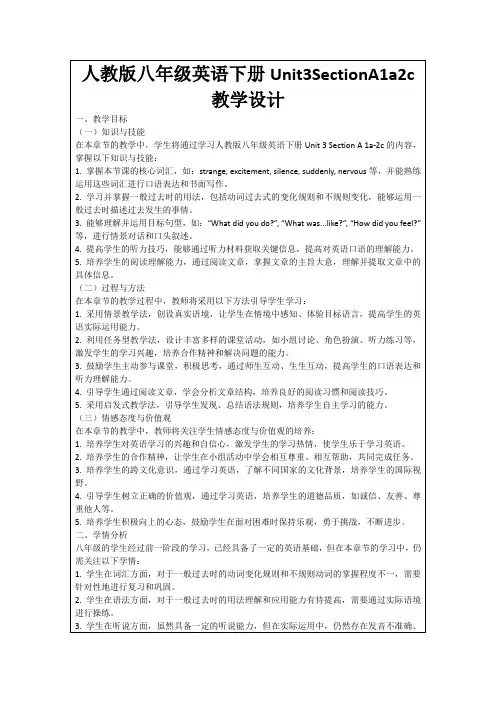
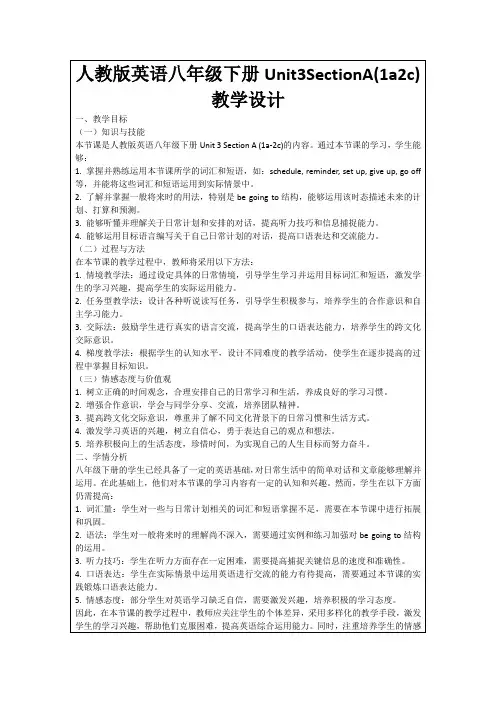
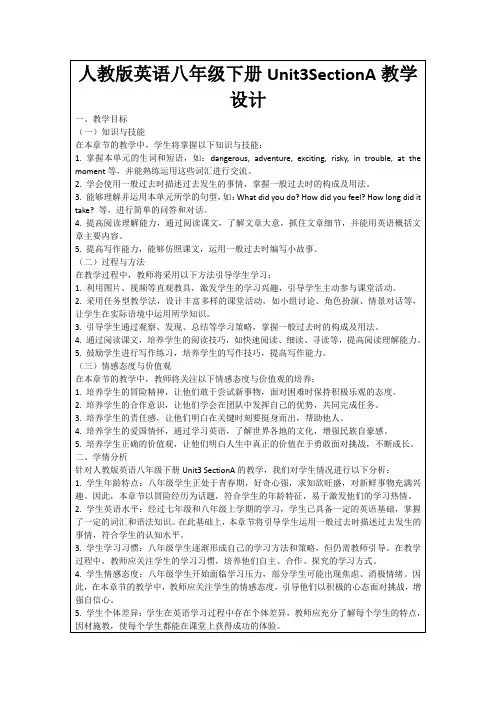
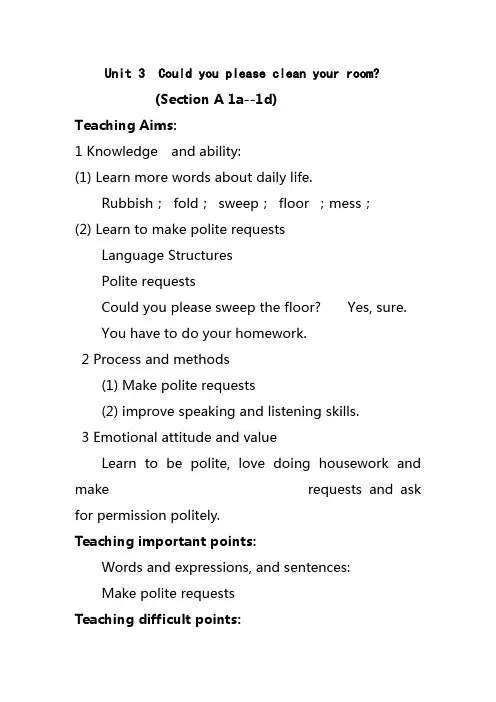
Unit 3 Could you please clean your room?(Section A 1a--1d)Teaching Aims:1 Knowledge and ability:(1) Learn more words about daily life.Rubbish;fold;sweep;floor ;mess;(2) Learn to make polite requestsLanguage StructuresPolite requestsCould you please sweep the floor? Yes, sure.You have to do your homework.2 Process and methods(1) Make polite requests(2) improve speaking and listening skills.3 Emotional attitude and valueLearn to be polite, love doing housework and make requests and ask for permission politely.Teaching important points:Words and expressions, and sentences:Make polite requestsTeaching difficult points:Make polite requestsTeaching MethodTask-Based language teachingTeaching AidsPPTTeaching ProceduresStep 1 Warming-upStep 2 Free talk---What are they doing now?Step 3 Presentation(1) Ask students: What housework do you usually do on weekends or in your free time?Get lots of answers like cleaning the house, doing the dishes , washing clothes and so on.(2)Teach new words and phrases by showing some pictures on the screen.Sweep the floor , take out of rubbish…(3)Practice in pairs.---Do you sweep the floor?---Yes, sure. I often do it on weekends. What about you? --- I often help my mother do the dishes.(4)Play a game:(guess What chore is she/he doing?)(5) The teacher shows the polite way to make requests.Ask students to compare two ways of requests.Peter, sweep the floor!Could you please sweep the floor,Peter?Then give the permission to the students. Yes, sure. No problem.If you can’t, you can say Sorry, I’m going to …. Or I have to …Practice with different students(6) Finish 1b. ( The teacher may use some instructions. For example, let’s check the answers together.)Step 4 practice in groupsShow a model on the screen .A: Could you please clean the living the room, Tony?B: Yes, sure. Could you please do the dishes, Tom?C: Sorry, I’m going to meet my friend later.B; Could you do the dishes, Linda?D. No problem.Step 5 Summing up.Step 6 Do some exercises.Step 7 HomeworkHelp your parents do some chores at home and write a dialogue between you.。
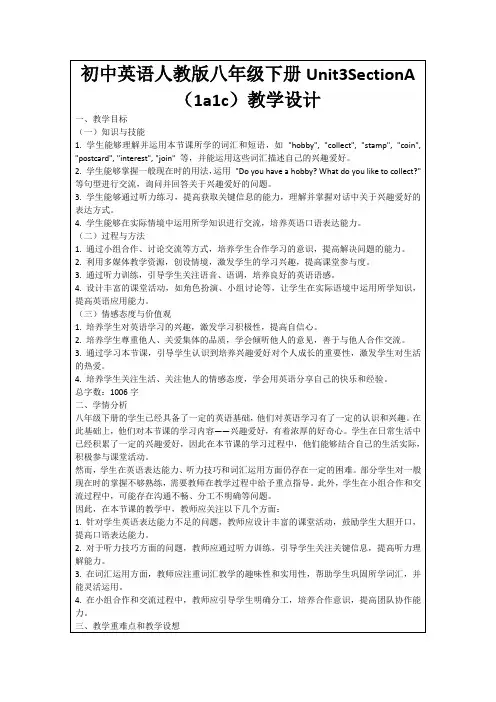

Unit 3 Could you please clean your room?Section A (1a1c)说课稿一、设计思路1、指导思想本节课选自新目标Go for it!人教版八年级英语下册第三单元的第一课时,本节内容是围绕“chores”这一话题展开,语言技能和语言知识都是依据这一中心话题而设计的。
重点在于通过听说来学习如何礼貌地提出请求和征求别人的许可,激发学生的兴趣,培养学生分担家务的习惯。
《英语课程标准》强调英语课程要从学生的学习兴趣,生活经验和认知水平出发,倡导体验、实践、参与、合作与交流的学习方式和任务型的教学途径,发展学生的综合英语运用能力。
基于课程标准的要求及学生的心理特点和认知发展规律,我设计了flash动画导入,情景会话,表演,个人点评等多种教学活动和方式来调动学生的学习兴趣;在教学策略方面采用了情境视听法、小组合作学习、任务型教学法,为学生设置真实的情景、语境,使学生在思考、交流、合作探究中学习和使用语言。
2、设计理念本节课在选材方面围绕“chores”的话题切入,非常贴近学生生活,有利于激起学生的英语学习热情。
体现了“从生活走向英语”的理念,运用flash动画、图片、声音媒体等手段教学,设置练习和实践所需的真实场景,营造良好的语言学习情景。
让学生感知英语的语言应用就在生活中。
引导学生透过对话练习,有效地培养了学生的英语语言技能,通过情感态度的培养,学生学会爱父母,爱家庭,爱劳动,学会如何与人交往,使他们的个性得到张扬。
3、教材分析本节课是新目go for it人教版八年级英语下册第三单元的第一课时。
本节课的中心话题是如何礼貌的请求对方做家务,通过谈论做家务,体会劳动的不易,培养做家务的习惯。
这一话题非常贴近学生生活实际,易于引发学生用英语进行交流。
学生通过对单词、短语、句型的学习以及对课件的观察和模仿,在实际操练中进一步提高了听力理解和综合运用语言的能力,且通过本节课的学习进一步培养了学生的合作意识、劳动意识,帮助学生学会关心他人,为父母分担家务的习惯。
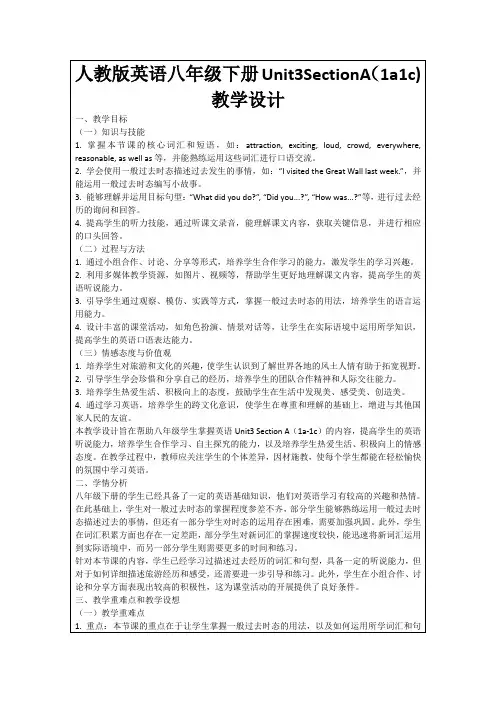
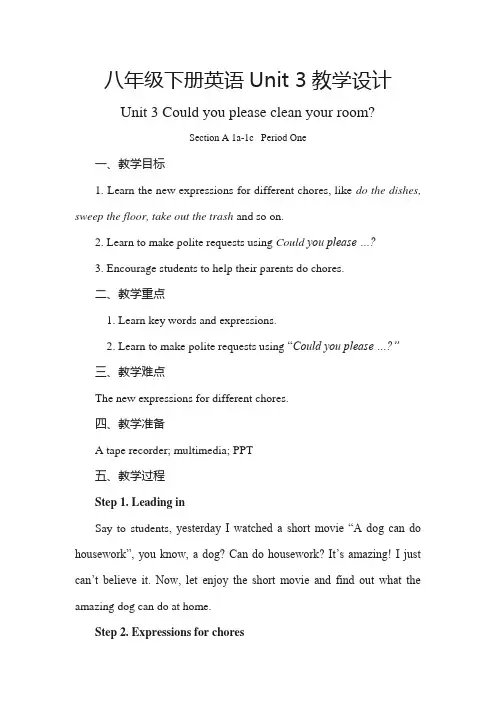
八年级下册英语Unit 3教学设计Unit 3 Could you please clean your room?Section A 1a-1c Period One一、教学目标1. Learn the new expressions for different chores, like do the dishes, sweep the floor, take out the trash and so on.2. Learn to make polite requests using Could you please …?3. Encourage students to help their parents do chores.二、教学重点1. Learn key words and expressions.2. Learn to make polite requests using “Could you please …?”三、教学难点The new expressions for different chores.四、教学准备A tape recorder; multimedia; PPT五、教学过程Step 1. Leading inSay to students, yesterday I watched a short movie “A dog can do housework”, you know, a dog? Can do housework? It’s amazing! I just can’t believe it. Now, let enjoy the short movie and find out what the amazing dog can do at home.Step 2. Expressions for choresShow the pictures. Teach the new expressions: do the dishes; take out the rubbish; fold your clothes; sweep the floor; make your bed; clean the living room…Teach the students how to read them and then ask them to repeat.Then teach new sentence structure: Could you please…?T: I think it’s a bit hot in the classroom, so I want someone to open the window, what can I say?Open the door!Please open the door!Could you please open the door?Can you find the difference? Which is the most polite expression?Practice the structure with doing chores.Step 3. Pairwork1a Point to the items in the box. Ask students what the word chores means. (A chore is a job you do at home.)Point to the items again and read each one to the class. Ask students to explain each chore in their own words and say if they do it or not. For example, a student might say, After we eat breakfast the dishes are dirty. We have to do the dishes. Do the dishes is the same as wash the dishes.Ask students to find a partner. As they work, move around the room and answer any questions.Find out which two chores most students do at home. Ask some students to write the name of each chore on the board. Then read the name of each chore to the class and say, Raise your hand if you do this chore. Write on the board the number of students who raise their hands after each chore.Step 4. Listening1b: Read the instructions.Point to the chart Show students the columns with the heading Mom and Peter? Say, Listen to the recording and check Mother or Peter.Play the recording the first time. Students only listen. Say, You will hear a conversation between Peter and his mom.Play the recording a second time. This time ask students to check Mother or Peter. Check the answers.Step 5. Pairwork1c: Point to the picture above. Ask students to point to different item in the picture and tell what chore is connected to each part of the picture.Point out the sample conversation in activity lc. Ask two students to read it to the class.Say, Now work with a partner. Ask each other to do the chores in activity la. First one student asks all the questions and the other student answers. Then the other student asks all the questions. You can answer. Yes, sure. All right, or OK.Step 6. Homework。
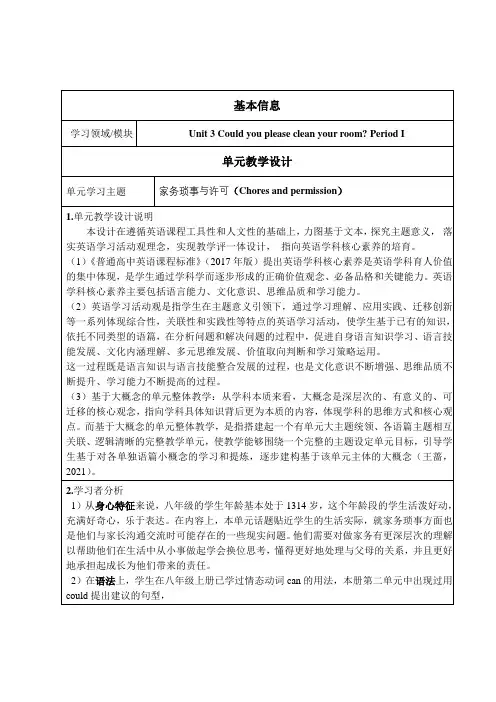
首先,通过学生Peter和自己的父母就有关做家务和外出的两个对话引出做家务和外出的问题,引导学生了解如何发出礼貌请求和得到许可。
之后,通过Peter为在家中举行派对跟妈妈进行的对话,引导学生总结怎样进行礼貌请求和得到许可。
然后通过Tony和Nancy 的对话再次体会做家务时如何进行礼貌请求和许可,进而引申到关于Nancy上个月与妈妈因为做家务起争执,但最终因为Nancy的主动认错和分担家务而和解的故事。
通过阅读让学生能够对做家务有正确的理解,学会为家人着想。
最后是关于从父母视角看待做家务的两篇文章,通过两篇文章对青少年做家务一正一反的阐述引导学生对做家务有进一步的认识并学会辩证地看待问题。
在此基础上,最后引导学生从青少年的视角看待做家务问题,认识到做家务对自己、家庭和社会的好处,从而更好地与家人共同分担家务。
单元的课时安排如下:课时教学设计第一课时课题Unit 3 Could you please clean your room?Period 1 Section A 1a1c课型新授课√章/单元复习课□ 专题复习课□ 习题/试卷讲评课□ 学科实践活动课□ 其他□1.教学内容分析What:单元话题:家务琐事和许可。
本单元的功能是做出礼貌请求和请求许可。
Section A 通过听说部分学习“Could you please …?”和“Could I …?”句型并能够据此做出礼貌请B: No problem.活动意图说明通过听力帮助学生获取关键信息,回答问题并完成表格,学会使用Could you please...?表示委婉的请求。
听后对话练习有利于学生进一步内化所学信息环节四:Post Listening教的活动4Step 4T helps Ss to summarize:1)What problems they have met?2)Do they solve them? 学的活动4Ss make a summary about what they have learnt.活动意图说明通过解忧杂货铺帮助学生总结所学。
Unit 3 Could you please clean your room?教学目标:1语言目标:谈论做家务的词汇,及如何有礼貌的提出要求。
2 技能目标:能听懂和谈论做家务的话题;能写出重点单词和重点句型。
3 情感目标:培养学生爱劳动,分享家务的能力。
教学重点短语: do the dishes, make the bed, take out the rubbish, fold the clothes, sweep the floor, clean the living room ……句子:1. Could you please take out the rubbish?. Sure. /No problem.教学难点:Make polite requestsStep 1 lead-in and present1.Talk about do you often help your parents do chores.2.Discuss what chores they can do. Show some pictures to present the newphrases.do the dishestake out the rubbishfold the clothessweep the floormake the bedclean the living room设计意图:以对话和图片的形式,激发学生的好奇心和参与的积极性Step 2 Listening1.Pre-listening.庭前观察1a的图,对听力内容进行猜测。
2.让学生浏览1a中的短语,理解每个短语的意思,然后和同桌讨论在家做家务的情况。
3.让学生浏览1b的表格,为听力做准备。
4.教师播放1b的录音,学生在表格对应的人物下面打勾,教师核对答案。
5.让学生大声朗读1c中的对话,并让学生两人一组,利用1a中的短语,仿照该对话来编新的对话。
Unit 3 sectionA1a-1c教学设计)设计:审核:________ 执教:_________ 使用时间:__________ Unit 3 Could you please clean your room?学习目标:1、学习生词P17—182、学习短语:clean one’s/the room, do the dishes, take out the rubbish,fold one’s/the clothes, sweep the floor, make one’s/the bed, clean the living room, go to the movies, get a ride3、学习句型:Could you please do sth?自主学习:1、根据音标和读音规则学习生词P17—182、读1a&1b并理解;3、理解2a合作学习:1、找出同意短语和同意词2、找出句型:Could you please do sth 的肯定回答和否定回答3、阅读并理解对话2c&2d展示点拨:1、do the dishes----wash the dishes;2、litter—trash---garbage---rubbish---waste3、rubbish n.----rubbishy adj 无聊的,没有价值的4、get a ride---give sb a ride----pick sb up---give sb a lift5、Could you please do sth?----Certainly/of course/with pleasure/sure/noproblem; Sorry, I can’t / sorry, I’m afraid I can’t巩固达标:一、用所给词的适当形式填空1、Could you please______(wash)your clothes?2、He is a good _______(clean),he wants to make our school more beautiful.3、Can you finish_______(read)the book today?4、Look out! The snake is still_______(live).5、The girl has to do the______(dish)after meals.二、单项选择1、--Could you please clean the classroom? ---Sure, I’ll do it right away.A. SorryB. OKC. No problemD. Thanks2、--Jim! Please wash the dishes. I’m busy now. ---OK, Mum.A. cleanB. sweepC. doD. does3、Students take turns to take out the rubbish every day.A. litterB. littleC. lessD. few4、--Could you help me with my English?---_____. I have to cook dinner for my family.A.Sorry, I can’tB. With pleasureC. No problemD. Certainly三、根据句子意思,将汉语翻译成英语1、The air in the class smells terrible. Please________(倒垃圾)after class.2、Please________(洗餐具)because too many flies here.3、You must_________(整理床铺)after you get up.4、The girl often_________(搭便车)home on Friday.5、The boy is going to______(帮忙)on the farm this summer.课堂小结:1、do the dishes----wash the dishes;2、litter—trash---garbage---rubbish---waste3、rubbish n.----rubbishy adj 无聊的,没有价值的4、get a ride---give sb a ride----pick sb up---give sb a lift5、Could you please do sth?----Certainly/of course/with pleasure/sure/noproblem; Sorry, I can’t / sorry, I’m afraid I can’t6、finish/enjoy/practice/consider/miss/mind/spend doing sth课后反思:。
Unit 3 Could you please clean your room?Section A 1a-1c 第一课时一、教学目标1.知识目标1)学习并掌握下列单词和有关家务的常用表达::rubbish; fold; sweep(swept); floor., do the dishes; take out the rubbish; fold your clothes; sweep the floor; make your bed; clean the living room;2)掌握重点句型Could you please……?及其正确礼貌回答方式。
2.能力目标:1)学生能正确使用所学新词和句型来表达日常生活中的锁事。
2)学生踊跃的参加课堂活动,大胆的开口用英语表达自己。
3)通过小组活动锻炼学生的团队合作能力。
3. 情感目标:1).在人际交往中学会礼貌用语,作一个有修养的好孩子。
2)让学生体会父母辛劳,主动帮助承担家务。
二、教学重难点1. 教学重点:①掌握新单词,正确使用本课所学短语和固定搭配。
②掌握Could you please…?两个重要句型以及其正确礼貌回答方式。
2 .教学难点:在实际的生活中如何委婉地表达自己的请求,获取帮助三、教学过程Step 1: Lead inT: Hello, boys and girls. How are you today? Fine, good. (Me? )T: I’m not fine. Why ? Because this morning my mom said: Could you please clean your room? It’s really in a mess(dirty). So today I’ll have too much housework to do .Step 2 Presentation1. T: Now look at the pictures of my house. It’s totally in a mess. So what chores I need to do. For example,板书sweep the floor, fold the clothes and take out the rubbish…….2. Group workT: Do you often do these chores at home (housework)? What chores do you usually do?T: Now let’s do a interview and find who is the most hardworking student in your group?Step 3 listening.1.Before listeningguide ss to observe the picture and answer my questionT: Who are the 2 people in the picture? Where are they?Will Peter take out the rubbish? How do you know that?.2. While listening(1) Now let’s listen to the conversation between Peter and his mother and find out who will do the chores.(2) During the second time, they will write down the 2 questions asked by Peter’s mother.Could you please take out the rubbish?Could you please make your bed and fold your clothes?3. After listening(1) Look at these two sentences? What will you find?板书Could you please do sth?(2) Compare the three sentences and find :Which sentence structure sounds more polite?Take out the rubbish, Peter.Can you take out the rubbish, Peter?Could you please take out the rubbish, Peter?(3) 在表示请求帮助或请求允许的疑问句中,我们常用could代替can,以表示礼貌,委婉或不确定的语气,而can则不具备这些语气。
Unit 3 Could you please clean your room?教学设计灵沼街道初级中学梁维维Teaching contents:Section A 1a----1cTeaching aims : 1 Knowledge objects:(1)Function: learn to make a polite requestand ask for permission.(2).Key vocabulary:do the dishes, make thebed, take out the rubbish, fold theclothes, , sweep the floor, clean the livingroom.(3)Target language:Could you/I please dothings? Yes, Sure. / I/You can.Sorry, I / you can’t,.., I / you have to do(4)Structure: Could for polite request.2 Ability objects(1)Be able to understand and master theconversations about making a politerequest.(2)Enable students to make a politerequest.3 Moral objects:(1)Let students know that it’s alwaysright to be polite.(2)Chores are part of fun in life. Teaching key points:1 Help students learn how to make politerequests with a target language.2 Be able to understand and make theconversations about making a politerequests.Teaching difficult points:Be able to make a polite request Teaching aids: ppt,Activity form and some prizesTeaching procedures:Step1 Warming upStep2. learn new words and phrasesLook! What is she / he dong? 看图学习动词词组do chores, dothe dishes, make the bed, take out therubbish, fold the clothes, , clean theliving room.Step 3. Guessing game. What is she doing ?Step 4. Pair work. 1a, Do you do these things at home? Write“Y” for “yes” and “N” for “no”. Step 5. Listening .1b , Peter’s chores or Mom’s chores?理解目标语Could you please clean your room? Yes, sure.Write “M” for Mom’s chores, “P” for Peter’s chores inthe chart.Step 6. PairworkLook at the picture, Ask your partner to do the chores thatyou see.Step7. Interview Who is the most able person at home?1) WWhat chores do you do at home? How often do you do the chores?Work in four, interview each of thestudents in the group, fill in thechart.2) The n one student make a report to the class. “In my group….Does the dishes every day,…We think …is the most able one in ourgroup.”3) 颁奖。
Unit 3 Could you please clean your room?
Section A 1a-1c 第一课时
一、教学目标
1.知识目标
1)学习并掌握下列单词和有关家务的常用表达::rubbish; fold; sweep(swept); floor., do the dishes; take
out the rubbish; fold your clothes; sweep the floor; make your bed; clean the living room;
2)掌握重点句型Could you please……?及其正确礼貌回答方式。
2.能力目标:
1)学生能正确使用所学新词和句型来表达日常生活中的锁事。
2)学生踊跃的参加课堂活动,大胆的开口用英语表达自己。
3)通过小组活动锻炼学生的团队合作能力。
3. 情感目标:1).在人际交往中学会礼貌用语,作一个有修养的好孩子。
2)让学生体会父母辛劳,主动帮助承担家务。
二、教学重难点
1. 教学重点:
①掌握新单词,正确使用本课所学短语和固定搭配。
②掌握Could you please…?两个重要句型以及其正确礼貌回答方式。
2 .教学难点:在实际的生活中如何委婉地表达自己的请求,获取帮助
三、教学过程
Step 1: Lead in
T: Hello, boys and girls. How are you today? Fine, good. (Me? )
really in
this morning my mom said: Could you please clean your room? It’s T: I’m not fine. Why ? Because
a mess(dirty). So today I’l l have too much housework to do .
Step 2 Presentation
1. T: Now look at the pictures of my house. It’s totally in a mess. So what chores I need to do. For example,
板书sweep the floor, fold the clothes and take out the rubbish…….
2. Group work
T: Do you often do these chores at home (housework)? What chores do you usually do?
T: Now let’s do a interview and find who is the most hardworking student in your group?
Step 3 listening.
1.Before listening
guide ss to observe the picture and answer my question
T: Who are the 2 people in the picture? Where are they?
Will Peter take out the rubbish? How do you know that?.
2. While listening
(1) Now let’s listen to the conversation between Peter and his mother and find out who will do the chores.
(2) During the second time, they will write down the 2 questions asked by Peter’s mother.
Could you please take out the rubbish?
Could you please make your bed and fold your clothes?
3. After listening
(1) Look at these two sentences? What will you find?
板书Could you please do sth?
(2) Compare the three sentences and find :Which sentence structure sounds more polite?
Take out the rubbish, Peter.
Can you take out the rubbish, Peter?
Could you please take out the rubbish, Peter?
(3) 在表示请求帮助或请求允许的疑问句中,我们常用could代替can,以表示礼貌,委婉或不确定的语气,而can则不具备这些语气。
这种情况下不能把could看作can的过去式。
以上两句中用could是为了表示礼貌的请求。
Step 4 Practice
Make conversations about the chores in 1a.
Examples:A: Could you please...?
B: Yes, sure. /All right. /No problem.
Sorry, I can't. I have to do...
Sorry, I can't. I am doing...
Step 5 Exercise
1、根据汉语和首字母提示完成单词。
2、汉译英
3、单项选择
Step 6 Summary
Ask student to sum up what we have learned today.
1.表示家务的短语。
做家务,洗餐具,清扫地板,取出垃圾,整理床铺,折叠衣服,清扫起居室……
2.Could you please后加______.表示委婉的请求。
你能…吗?
肯定回答常用_________________
否定回答常用______________________
Step 7 Homework
1. List all the main phrases of doing chores that you know. (必做)
2 .Make a conversation between you and your mother, using the sentence pattern “Could you
(选做)
please …?”
四、板书设计
Unit 3 Could you please clean your room?
Section A 1a—1c
do the dishes
take out the rubbish
A: Could you please fold your clothes ?
sweep the floor
…….
B: Yes, sure. /All right. /No problem. Sorry, I can't.。